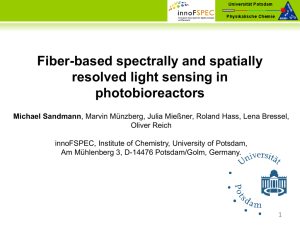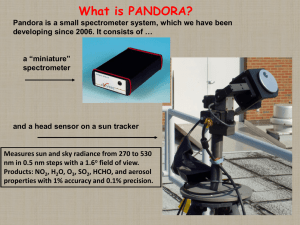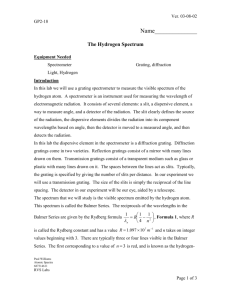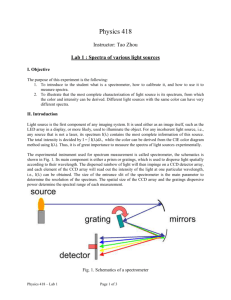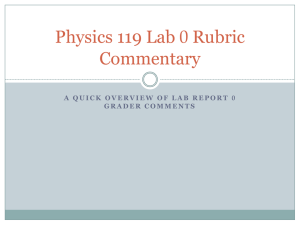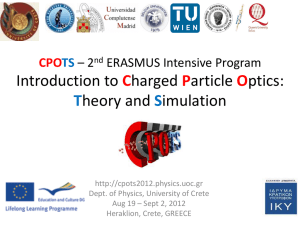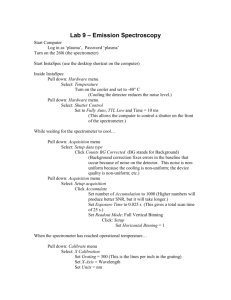Application of a FTUV system to measure ambient pollution in
advertisement
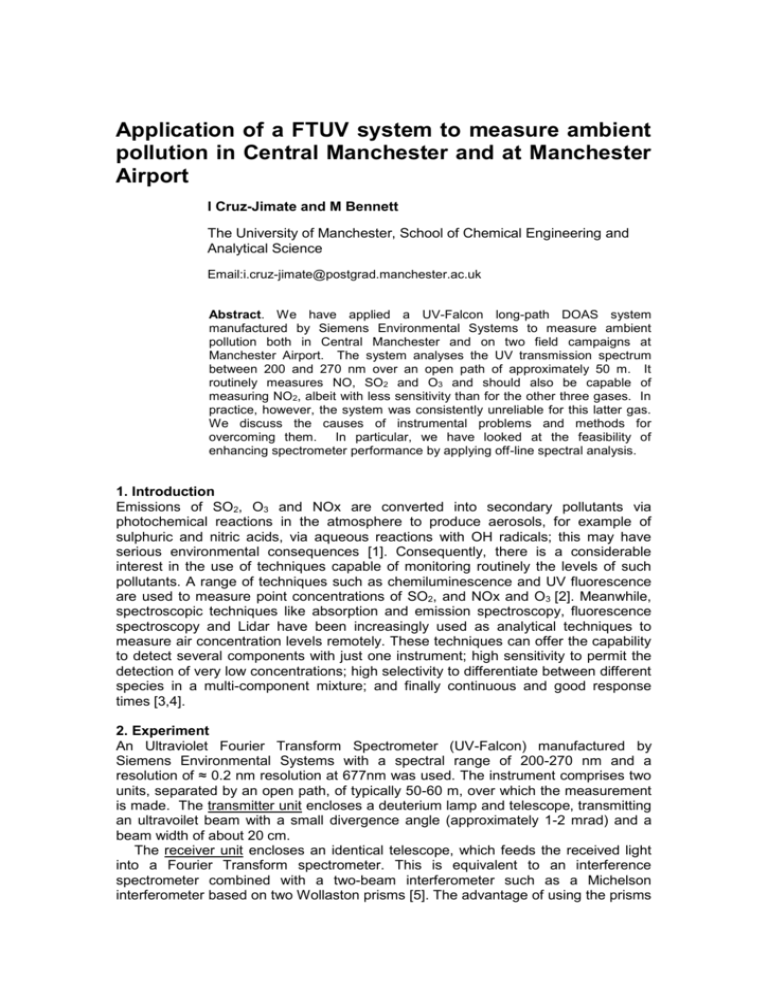
Application of a FTUV system to measure ambient pollution in Central Manchester and at Manchester Airport I Cruz-Jimate and M Bennett The University of Manchester, School of Chemical Engineering and Analytical Science Email:i.cruz-jimate@postgrad.manchester.ac.uk Abstract. We have applied a UV-Falcon long-path DOAS system manufactured by Siemens Environmental Systems to measure ambient pollution both in Central Manchester and on two field campaigns at Manchester Airport. The system analyses the UV transmission spectrum between 200 and 270 nm over an open path of approximately 50 m. It routinely measures NO, SO2 and O3 and should also be capable of measuring NO2, albeit with less sensitivity than for the other three gases. In practice, however, the system was consistently unreliable for this latter gas. We discuss the causes of instrumental problems and methods for overcoming them. In particular, we have looked at the feasibility of enhancing spectrometer performance by applying off-line spectral analysis. 1. Introduction Emissions of SO2, O3 and NOx are converted into secondary pollutants via photochemical reactions in the atmosphere to produce aerosols, for example of sulphuric and nitric acids, via aqueous reactions with OH radicals; this may have serious environmental consequences [1]. Consequently, there is a considerable interest in the use of techniques capable of monitoring routinely the levels of such pollutants. A range of techniques such as chemiluminescence and UV fluorescence are used to measure point concentrations of SO2, and NOx and O3 [2]. Meanwhile, spectroscopic techniques like absorption and emission spectroscopy, fluorescence spectroscopy and Lidar have been increasingly used as analytical techniques to measure air concentration levels remotely. These techniques can offer the capability to detect several components with just one instrument; high sensitivity to permit the detection of very low concentrations; high selectivity to differentiate between different species in a multi-component mixture; and finally continuous and good response times [3,4]. 2. Experiment An Ultraviolet Fourier Transform Spectrometer (UV-Falcon) manufactured by Siemens Environmental Systems with a spectral range of 200-270 nm and a resolution of ≈ 0.2 nm resolution at 677nm was used. The instrument comprises two units, separated by an open path, of typically 50-60 m, over which the measurement is made. The transmitter unit encloses a deuterium lamp and telescope, transmitting an ultravoilet beam with a small divergence angle (approximately 1-2 mrad) and a beam width of about 20 cm. The receiver unit encloses an identical telescope, which feeds the received light into a Fourier Transform spectrometer. This is equivalent to an interference spectrometer combined with a two-beam interferometer such as a Michelson interferometer based on two Wollaston prisms [5]. The advantage of using the prisms is to introduce a path difference between the two orthogonal polarizations, which varies linearly with the lateral position of the input ray, when the output rays are sent through a polarizer. After this, the spectrometer obtains spectra from the interference patterns (interferogram) generated by the interferometer [6]. The UV bandpass filter of the spectrometer transmits wavelengths in the range 190-270nm, in order to limit the effects of ambient light. The data acquisition rate of the spectrometer was 0.25 ms-0.5 ms [7]. The Fourier transform of the interferogram is then calculated, using a fast Fourier transform [5,8,9], to obtain a transmission spectrum. This is in turn normalized by a ‘reference’ spectrum obtained from nominally clean air: this procedure corrects for the spectra output profile of the lamp and the effects of windows materials and spectrometer optics, though at the cost of making all reported concentrations relative to the absolute concentrations in the ‘clean’ air at the time the reference spectrum was taken. This normalized gas transmission spectrum undergoes a curve-fitting process [10] against library absorption spectra to estimate ambient gas concentrations. Finally, the receiver unit was connected to a computer via an RS 232 serial data channel to monitor and archive gas concentrations, The location for the monitoring campaign carried out in the City of Manchester was in the Sackville Street Campus of the University of Manchester. This campus (formerly UMIST) is bounded on the east by the London Road (A6) and on the south by the Mancunian Way (A57 M). Both roads have high traffic density during the peak hours in the morning and in the afternoon. In addition, the campus is close to Manchester's main rail terminal, Piccadilly Station. At this site, the transmitter unit was installed on the roof of The Morton Laboratory and the receiver unit was installed on the roof of the Mill Building with an open path of 51 m, and an average height of 20 m above ground level. Air pollution concentrations at ground level in the nearby Piccadilly Gardens were available from the national Air Quality Archive (AQA) [2]. The location for the monitoring campaign carried out at Manchester Airport is shown in figure 1. This was located approximately 150 m from the eastern end of Runway 1 with an open path (across the line of the runway) of 55 m. Associated computing equipment was installed in a small cabin belong to National Air Traffic Services. A hand held GPS was used to acquire positional information of the spectrometer (North 53.36,369°, West 02.25,359°). a) b) Figure 1 (a) Southern view of the Runway 1 in Manchester Airport showing the NATS cabin where the spectrometer was installed (b) UV-Falcon beside the NATS cabin during the second campaign. NO, NO2, O3 and SO2 were included in the fitting process during both campaigns and their concentrations were evaluated in real time. Depending on wind direction, the emissions of individual aircraft could be detected. The NO2 performance, however, was very unreliable for all monitoring periods. 3. Reanalysis In order to obtain useful NO2 concentrations, we applied a series of strategies. Firstly, we downloaded the library data stored in the software of the instrument. These data were the transmission spectrum from all gases, the accurate wavelength table used by the instrument, the normalised spectra and the interferograms. From this information we took the normalised spectra to re-build the process and derive a high pass absorption cross-section filter that could be subtracted from the absolute cross section from our readings [11,12]. The process to construct this filter was applied to the gases, with their corresponding calibration concentration and path length (X0L0), and their transmission spectra (T) stored in the spectrometer libraries. We took the following assumptions, based on the Lambert-Beer law. Our system is using a light source of intensity I(l) sampled with a system of gain G(l) and this undergoes an absorption process caused by several gases. This effect gives us a measured spectrum. M (l ) I (l )G (l ). exp n ai ( l ) xi L i Equation 1 where, l is the wavelength, I(l) is the intensity of the source, M(l) is the measured spectrum, G(l) is the gain of the system, ai(l) are the absorption efficiencies, x i are the concentrations of the species of interest and L is the open path length. Also, we are using the absorption efficiencies implicit in the library of the transmission spectra: Ti (l ) exp n ai (l ) X 0 L0 i Equation 2 where Ti(l) is the transmission spectrum of the ith species. Obviously, 0<T<1. Assuming that I(l) and G(l) do not vary with time, we can express the sums in the exponents as functions of the ratio of the measured spectrum to the reference spectrum for each species. Thus M i ( ) n L ln ( xi xrefi ) ln( Ti ( )) M ref ( ) x0i L0 i i 1 Equation 3 where, xi-xi(ref) is the reported concentration from the UV-Falcon. From this point we could apply our own spectral-fitting process based on multiple linear regression [10,13] to compare with the Falcon’s reported results. One complication was that the spectrometer measures intensity at 137 wavelengths, whose precise values vary from instrument to instrument. The library transmission spectra, however, had not been obtained with the same instrument and were therefore not directly applicable to our spectrometer. We overcame this problem by applying a cubic spline to interpolate to the correct wavelengths. Finally, we used the interferogram to derive a cosine Fourier transform and then using it match the library NO2 transmission cross section better to the real performance of our instrument. The interferogram consists of 1024 elements with about 300 zeros at the beginning and at the end of the array and a maximum close to pixel number 512. The final two pixels also seemed to have been assigned a high value: these were removed in subsequent processing. More interestingly, we noted that there was a large variation in the intensity at the edge of the non-zero interferogram. We wondered if the Fourier transform of this variation would give a spurious oscillatory structure to the transmission spectrum, which could match the oscillatory structure of the NO2 transmission spectrum. We applied a cosine Fourier transform (CFT) to remove these pixels by taking the relationship between the pathlength difference (x) and the wavenumber (f). This is given by w( f ) 1 2 cos(2fx)w( x)x Equation 4 We assume that x denotes the path-length difference between the two beams in the spectrometer and fit this against the pixel number, P. Then while f is the wavenumber, f=n/L, the signal from each wavenumber is a maximum at the middle of the array, where the path difference is zero. The maximum permissible wavenumber is at n=512, since at this frequency the received signal will alternate between peak and trough from one pixel to the next one. We only wish to retain the steady, nonzero signal between P1 and P2, and hence x=(P2-P1/1024)L. Taking the CFT of this window, gives us a matched filter in frequency space with which to convolve the library NO2 spectrum. We performed the convolution of the NO2 spectrum, the interferogram analysis, the reconstruction and regression processes using Matlab Version 7.0.4. [14]. ' ( NO2 )conv ( NO2 ) CFT Equation 5 4. Results and Discussion The ambient concentrations of NO, SO2 and O3 monitored during the campaigns in Central Manchester consistently have been shown a good performance. Figure 2 shows some monitoring results obtained in Manchester City Centre. Figure 2 (a) First monitoring campaign on August 2005 and (b) second monitoring campaign on December 2005, carried out on Manchester City Centre. We note that the best performance was for NO, with a correlation coefficient of 0.8, falling to 0.7 for SO2 and worse for O3. For the O3 results we assumed that some unknown interferant species was confusing the multiple fitting algorithm. No signal response was achieved for NO2 during the first campaign, while an intermittent response was found for this gas during the second campaign. This was not thought not be significant. During September 2006 and in March-April 2006, we undertook two monitoring campaigns at Manchester Airport. The spectrometer performance was compared again with the Air Quality Archive (AQA), taking the reported values from Manchester South monitoring point. The Falcon was working continuously, but we had access to the airport only for 5-10 min each day to verify the operational conditions of the spectrometer and to fix any alignment problems. For the first campaign, the weather was sometimes windy, with rain on only a single day. The ground was generally stable, with little mechanical vibration affecting the spectrometer. For the second campaign the weather was windy, cold and wet. The ground was then soft and much more vibration affected our work. As is shown in figure 1, the transmission unit had to be placed on the grass. The spectrometer was approximately 150 m from the end of Runway 1 and, with typically a few minutes between flights, the spectrometer was able to detect individual aircraft on take-off or landing. Figure 3 shows the results obtained at this location. Here we had applied the offline analysis using the convolved NO2 absorption spectrum and some interesting results were achieved. Figure 3 (a) Profiles of the gases concentration on the 6 th of September 2005 during the first monitoring campaign and (b) profiles of the gases concentration on the 4 th of April during the second monitoring campaign on the Manchester Airport. As is shown in figure 3, similar trends for both the Falcon and AQA were found for all gases. The absolute concentrations observed were also similar: for NO the results were 10 g m-3 for both the Falcon and AQA; for SO2 it was 5 and 3 g m-3 respectively, while for O3 it was 37 and 23 g m-3. For NO2 is was 31 and 25 g m-3, though with a poorer time correlation than for the other gases. Moving on to the second campaign, the results were that an improved trend was found for all gases, though as in the first campaign we saw a significant difference in absolute concentrations between the Falcon and AQA for O3. The quantitative results were; for NO 14 and 13 g m-3 for Falcon and AQA, and from SO2 were 9 and 5 g m-3, from O3 were 20 and 48 g m-3 and from NO2 were 19 and 28 g m-3 respectively. In addition, we verified the goodness of the reconstruction process by comparing the results obtained from this process with the results given directly by the Falcon. We found higher correlation coefficients around 0.96 to 0.99 correlations between our data set and the spectrometer data. 5. Conclusion The FTUV spectrometer (UV-Falcon) was used to measure NO, SO2 and O3 routinely over several campaigns. Moderate agreement was obtained with equivalent values provided by the national Air Quality Archive. The performance was much less good, however, for NO2. By convolving the NO2 spectrum held in the instrument’s library with a matched filter more closely related to the real performance of the spectrometer, improved measurements of NO2 were obtained. Acknowledgments This work was undertaken through a grant from the National Council of Science and Technology of Mexico, CONACyT. The uv-Falcon was purchased under the EPSRC Joint Infrastructure Fund. We are grateful to Manchester Airport PLC for permission to operate at the airport and to National Air Traffic Services permission to use their cabin. We are most grateful to the staff of both organizations for their help and patience while we were carrying out the work. References [1] [2] [3] [4] [5] [6] [7] [8] [9] [10] [11] [12] [13] [14] J H Seinfeld, S N Pandis, ‘Atmospheric Chemistry and Physics: From Air Pollution to Climate Change’, Wiley Interscience 1998. http://www.airquality.co.uk. (2006). The Air Quality Archive, Netcen. SR Ahmad “Application of lidar to atmosphere pollution mapping: a review”, Proc. SPIE, 3127, pp1-13, (1997). M W Sigrist (1994). ‘Air Monitoring by Spectroscopy Techniques', Wiley Interscience. M J Padgett, A R Harvey, A J Duncan, W Sibbett (1994).‘Single-Pulse, FourierTransform Spectrometer Having No Moving Parts'. Applied Optics, 33(25), 6035-6040. M J Padgett, A R Harvey (1995). ‘A Static Fourier-Transform Spectrometer Based on Wollaston Prisms’. Review of Scientific Instruments, 66(4), 2807-2811. B A Patterson, M Antoni, J Courtial, A J Duncan, W Sibbett, M J Padgett (1996). ‘An Ultra-Compact Static Fourier-Transform Spectrometer Based on a Single Birefringent Component’.Optics Communications, 130(1-3), 1-6. J J Snyder (1980), ‘Algorithm for fast digital analysis of interference fringes’. 19(8), 1223-1225. Applied Optics. J W T Cooley (1965), ‘An Algorithm for the Machine Calculation of Complex Fourier Series’. Math Comput, 19, 297. J Stutz, U Platt (1996), ‘Numerical Analysis and Estimation of the Statistical Error of Differential Optical Absorption Spectroscopy Measurements With Least-Squares Methods’. Applied Optics, 35(30), 6041-6053. T Etzkorn, B Klotz , S Sorensen, I V Patroescu, I Barnes, K H Becker, U Plantt, ‘Gasphase absorption cross section of 24 monocyclic aromatic hydrocarbons in the UV and IR spectral ranges’. Atmospheric Environment, vol.33, pp. 525- 540, 1999 R Volkamer, T Etzkorn, A Geyer, and U Platt (1998), ‘Correction of the Oxygen Interference with UV Spectroscopic (DOAS) Measurements of Monocyclic Aromatic Hydrocarbons in the Atmosphere’. Atmospheric Environment, 32(21), 3731-3747. Ch Wu, M Y Yost, R A Hashmonay, M Tsai (2003) ‘Path concentration profile reconstruction of optical remote sensing measurements using polynomial curve fitting procedures.’ Atmospheric Environment, 37, 1879-1888. Matlab 7.0.4, The language of technical computing, Version 7.0.4.365, (R14)

